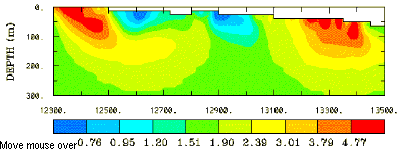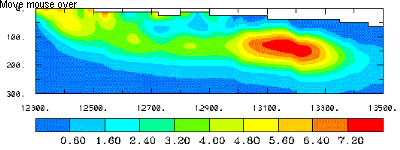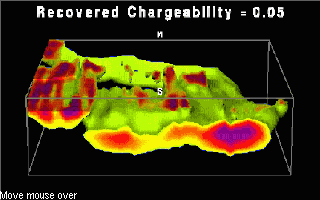| |
 Introduction Introduction
Location: This example, courtesy of Placer Dome, is from a deposit in central British Columbia. Many geophysical data sets have been inverted, either singly, jointly, and/or cooperatively. There is a complete writeup of UBC-GIF work on this deposit in Geophysics, Vol. 62, No. 5, pg 1419-1431.
Geology: The essential feature of the zone is a monzonitic stock intruded into volcanics. There has been hydrothermal alteration near the boundaries of stock and porous trachytic units. The whole deposit has been complicated by subsequent faulting, rotation and erosion. The deposit is a Cu-Au porphyry occurring within porphyritic monzonite stocks and Takla group volcanics.
DC resistivity and IP survey: Conventional pole-dipole resistivity and induced polarization (phase measurements) profiling was done, with a=50 metres, and n = 1-4. There were a total of 11 parallel lines 100 metres apart. We present results from one line, as well as an animated 3D image of the chargeability model found by concatenating all 2D inversion models obtained from the complete chargeability data set.
DC resistivity and IP data
The following images show the observed apparent conductivity and chargeability pseudosections from line 9600N, and predicted data generated by forward modeling on recovered models.

Psuedosection of resistivity data along line 9600N. Small scale features near the surface overwhelm data from features at greater depths. Scale is in units of log conductivity (log mS/m). Mouseover to see predicted resistivity data based on the recovered model. |

Psuedosection of chargeability data along line 9600N, scaled in units of mrad. Again, small scale, near-surface features dominate the left half of the line. The deeper feature is identifiable right of centre. Mouseover to see predicted chargeability data. |
Results of 2D inversion of resistivity and chargeability data
In the resistivity model, the MBX stock is recognized as a zone that is slightly more conductive than the host rocks. Other conductive regions are associated with faults. Surface features are reasonably well delineated. Move your mouse over the inversion result to see geology overlaid.
Chargeability structure under line 9600N is shown next. Overlaid on the chargeability model (move your mouse over the second figure) are contours of gold concentrations, coloured by category. On a scale of 1 to 4, highest concentrations (catagory 4) are shown in red, and catagory 3 is shown in pink. This geochemical information was obtained from borehole work. Comparison between geology (overlaid on the resistivity model) and chargeability shows how the chargeable zone is associated with the rainbow dyke, and the MBX stock unit tends to be less chargeable than its neighbouring units. These types of correlations between physical properties and geologic units, structure, alteration, and mineralization provide unique and critical information about the deposit and its associated geology.

2D conductivity structure recovered by inversion. Scale is in log mS/m. Mouseover to see geology overlaid, which was interpeted from numerous boreholes. |

Chargeability structure (units of mrad) recovered by inversion. Mineralization, structure and small scale surface features are all identifiable in the model. Mouseover to see relative gold concentrations overlaid, interpreted from borehole data. |
3D image and animation from eleven 2D inversions under parallel survey lines
Concatenation of inversion results from 11 parallel survey lines permits visualization in three dimensions. The image below was generated by building a three dimensional volume from 2D inversions. Then an isosurface at 0.05 mrad was imaged. Mouseover on the figure to see an animation of this volume rendering.
Mouseover for animation

The animation was constructed by inverting eleven parallel lines of conventional resistivity - IP data, then concatenating the inverted models and interpolating between them to produce a 3D volume model of chargeability. The image shows the surface where chargeability is 0.05 rendered as an isosurface. Animation is then generated by re-rendering at multiple points of view.
There are also two 3D images of this ore body generated by 3D inversion of magnetic data and a fully 3D inversion of chargeability (as distinct from concatenated 2D models). See the Mt. Milligan magnetics case history. |
|


